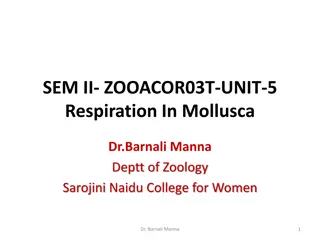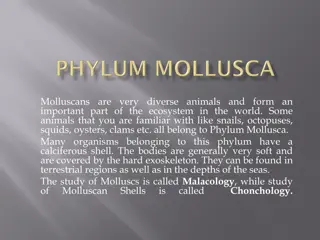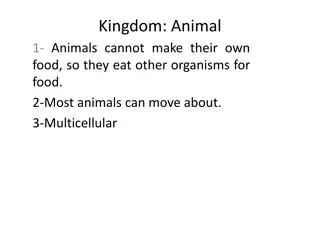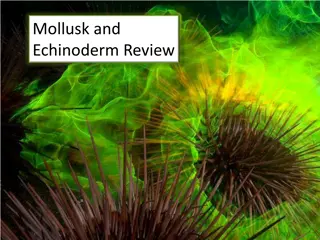Respiration in Mollusca: Adaptations to Different Habitats
Mollusca exhibit various modes of respiration depending on their habitat - aquatic, terrestrial, or amphibious. Different respiratory organs are modified accordingly, such as ctenidia or gills for aquatic species, pulmonary sac for aerial species, and mantle or integument for those lacking specific
0 views • 17 slides
The Diverse World of Molluscs: An Overview
Molluscs are diverse animals found in both terrestrial and aquatic habitats. They belong to Phylum Mollusca and exhibit characteristics such as a calciferous shell, bilateral symmetry, and a well-developed body system. The study of Molluscs is called Malacology, while the study of Molluscan Shells i
3 views • 11 slides
Overview of Animal Kingdom's Phyla and Characteristics
Animals in the Kingdom Animalia have diverse characteristics and are classified into different phyla based on specific traits and features. This includes Porifera (sponges), Cnidaria (jellyfishes), Platyhelminthes (flatworms), Nematoda (roundworms), Annelida (earthworms), Mollusca (snails, octopus),
0 views • 10 slides
Exploring Mollusks and Echinoderms
Delve into the fascinating world of Mollusks and Echinoderms through this informative review. Learn about their unique characteristics such as radula, tube feet, gills, and bilateral symmetry. Discover the importance of these features in the diverse phyla of Mollusca and Echinodermata, including the
0 views • 25 slides
Overview of Mollusca Classification and Characteristics
The phylum Mollusca includes organisms with diverse characteristics such as marine and freshwater habitats, a range of body structures, and unique reproductive strategies. This overview discusses the classification of Mollusca, covering groups like Aplacophora, Gastropoda, Bivalvia, and Cephalopoda,
0 views • 10 slides




